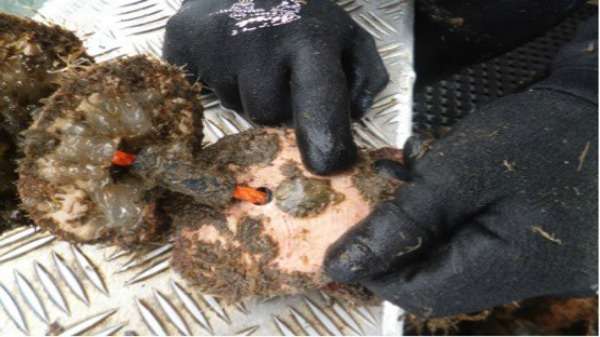The growth of Ostrea angasi after five weeks in Oyster Harbour.
A Western Australian first trial to return oysters to an Albany estuary is exceeding scientists' expectations, a year into the ambitious project.
The Nature Conservancy Australia (TNCA) expanded their Australian first pilot shellfish reef restoration program in Port Phillip Bay, near Melbourne, to Albany's Oyster Harbour in September last year.
Oysters were once abundant in the estuary, which was named by British explorer George Vancouver after his ship ran aground on an oyster reef in 1791.
UWA Albany Professor Peter Cook, an internationally recognised abalone expert, says fishing methods in the 1800s involved dredging the seafloor, which removed an estimated 90 per cent of the oysters' habitat.
Eighty-five per cent of oyster reefs have been lost worldwide due to overfishing, pollution and habitat loss, according to TNCA.
TNCA marine manager Dr Chris Gillies says oysters improve water quality by filtering seawater at a rate of up to five litres per hour – enough to fill a bathtub in a day.
It is hoped re-establishing the oyster ecosystem will improve Oyster Harbour's health and attract fish for recreational fishers.
The project aims to assess the survival and growth of Ostrea angasi, or native flat oyster, over three to four years to test reef restoration methods.
In December, six million oyster larvae were produced from brood stock collected from Oyster Harbour.
After a month in a commercial hatchery, the juvenile oysters (known as spat) were settled onto recycled oyster, scallop and abalone shells.
In February, they were transferred to mussel farm lines in Oyster Harbour, while artificial reefs were built.
Divers arranged 15 tonnes of laterite rock into two 3m by 4m restoration plots and two 3m by 4m control plots on the harbour floor in May.
Prof Cook says mortality rates on the mussel lines were high, but the "couple of million" juvenile oysters relocated onto the artificial reefs have shown good growth rates over the past five months.
"It has certainly exceeded our expectations, because we weren't sure if we would get any surviving at all," he says.
Data loggers record salinity and temperature at each site, while remote underwater video monitors fish activity.
Over the next three months, the process will be repeated and a third artificial reef may be installed.
"The long-term objective of the project is to… go from small plots… to hectares and generate a self-sustaining population of oysters," Prof Cook says.
"Eventually, we would hope to bring back at least part of the harbour to what was originally a productive oyster reef, but that is a long-term project."
Provided by Science Network WA
This article first appeared on ScienceNetwork Western Australia a science news website based at Scitech.






















